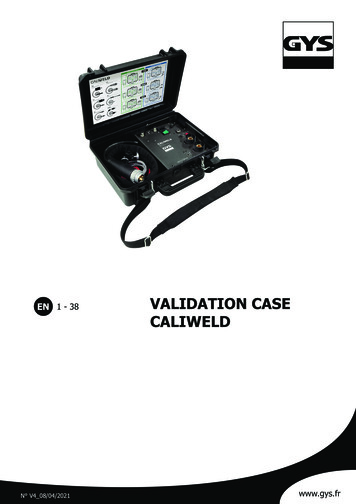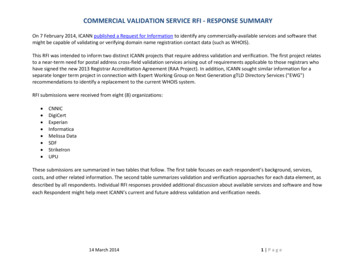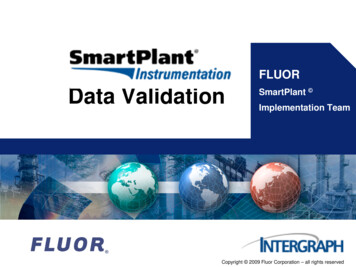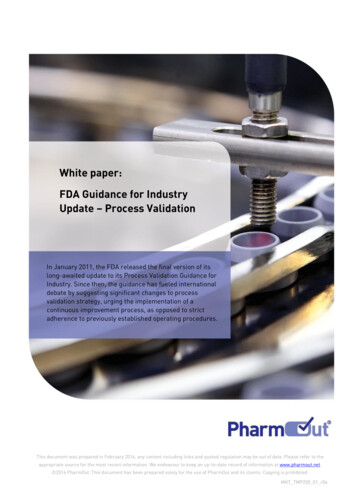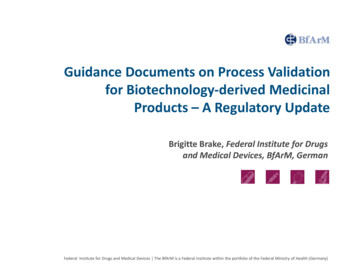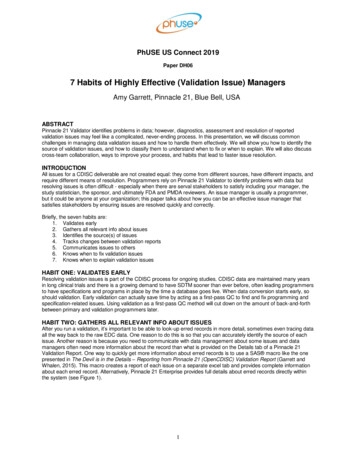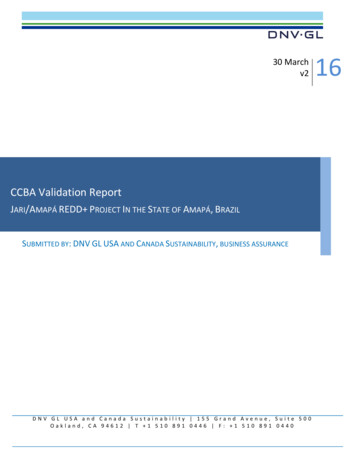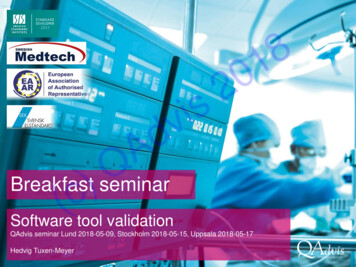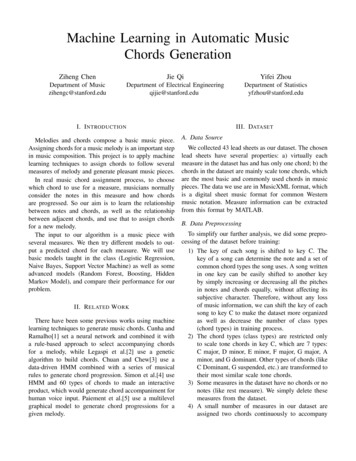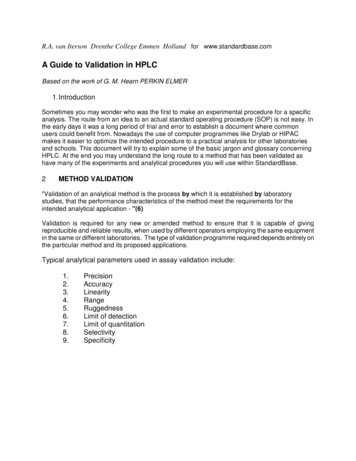
Transcription
R.A. van Iterson Drenthe College Emmen Holland for www.standardbase.comA Guide to Validation in HPLCBased on the work of G. M. Hearn PERKIN ELMER1. IntroductionSometimes you may wonder who was the first to make an experimental procedure for a specificanalysis. The route from an idea to an actual standard operating procedure (SOP) is not easy. Inthe early days it was a long period of trial and error to establish a document where commonusers could benefit from. Nowadays the use of computer programmes like Drylab or HIPACmakes it easier to optimize the intended procedure to a practical analysis for other laboratoriesand schools. This document will try to explain some of the basic jargon and glossary concerningHPLC. At the end you may understand the long route to a method that has been validated ashave many of the experiments and analytical procedures you will use within StandardBase.2METHOD VALIDATION"Validation of an analytical method is the process by which it is established by laboratorystudies, that the performance characteristics of the method meet the requirements for theintended analytical application - "(6)Validation is required for any new or amended method to ensure that it is capable of givingreproducible and reliable results, when used by different operators employing the same equipmentin the same or different laboratories. The type of validation programme required depends entirely onthe particular method and its proposed applications.Typical analytical parameters used in assay validation tyRangeRuggednessLimit of detectionLimit of quantitationSelectivitySpecificity
R.A. van Iterson Drenthe College Emmen Holland for www.standardbase.com2.1Precision"The precision of an analytical method is the degree of agreement among individualtest results obtained when the method is applied to multiple sampling of ahomogenous sample -"(6)Precision is a measure of the reproducibility of the whole analytical method (includingsampling, sample preparation and analysis) under normal operating circumstances.Precision is determined by using the method to assay a sample for a sufficient number oftimes to obtain statistically valid results (ie between 6 - 1 0). The precision is thenexpressed as the relative standard deviationstd dev x 100%%RSD mean2.2 Accuracy"Accuracy is a measure of the closeness of test results obtained by a method to thetrue value. " (6)Accuracy indicates the deviation between the mean value found and the true value. lt isdetermined by applying the method to samples to which known amounts of analyte havebeen added. These should be analysed against standard and blank solutions to ensurethat no interference exists. The accuracy is then calculated from the test results as apercentage of the analyte recovered by the assay.Accuracy and precision are not the same, as the diagram below indicates. A method canhave good precision and yet not be accurate.Errors in measurement can be divided into two general categories: systematic errors and
R.A. van Iterson Drenthe College Emmen Holland for www.standardbase.comrandom errors.Systematic errors result from sources that can be traced to the methodology, theinstrument or the operator, and affect both the accuracy and the precision of themeasurement.Random errors only affect the precision, and are difficult to eliminate, because they are theresult of random fluctuations in the measured signal, due to noise and other factors.Whilst systematic errors are proportional to the sum of individual contributions, randomerrors are proportional to the root of the sum of the squares of the individual contributions.Thus, the imprecision of the entire procedure is often dominated by the random errors ofthe most imprecise step.2.3 LinearityThis is the method's ability to obtain results which are either directly, or after mathematicaltransformation proportional to the concentration of the analyte within a given range.Linearity is determined by calculating the regression line using a mathematical treatment ofthe results (ie least mean squares) vs analyte concentration.2.4 RangeThe range of the method is the interval between the upper and lower levels of an analytethat have been determined with acceptable precision, accuracy and linearity. It isdetermined on either a linear or nonlinear response curve (ie where more than one range isinvolved, as shown below) and is normally expressed in the same units as the test results.
R.A. van Iterson Drenthe College Emmen Holland for www.standardbase.com2.5 RuggednessRuggedness is the degree of reproducibility of results obtained by the analysis of the samesample under a variety of normal test conditions ie different analysts, laboratories,instruments, reagents, assay temperatures, small variations in mobile phase, different daysetc. (ie from laboratory to laboratory, from analyst to analyst.)2.6 Limit of DetectionThis is the lowest concentration in a sample that can be detected, but not necessarilyquantitated, under the stated experimental conditions. The limit of detection is importantfor impurity tests and the assays of dosages containing low drug levels and placebos.The limit of detection is generally quoted as the concentration yielding a signal-to-noiseratio of 2:1 and is confirmed by analyzing a number of samples near this value (6) usingthe following equation. The signal-to-noise ratio (5) is determined by:s H/hWhere H height of the peak corresponding to the componenth absolute value of the largest noise fluctuation from the baseline of thechromatogram of a blank solution.Since the limit of detection is dependant on the signal-to-noise ratio, itcan be improved by enhancing the analyte signal and reducing the detector noise.The signal (ie peak height) can be increased by selecting the optimum monitoringwavelength, increasing the injection volume or mass (below signal or column saturation),increasing the peak sharpness with high efficiency columns and by optimizing the mobilephase. For absorbance detectors, longer path lengths in the flow cell enhances sensitivitythough often to the detriment of post column dispersion.Noise can be reduced by using high sensitivity detectors with low noise and driftcharacteristics, slower detector response time, mobile phases with low absorbance andpumps with low pulsation.2.7Limit of QuantitationThis is the lowest concentration of analyte in a sample that can be determined withacceptable precision and accuracy.lt is quoted as the concentration yielding a signal-to-noise ratio of 1 0: 1 and is confirmedby analyzing a number of samples near this value (5).2.8 Selectivity and Specificity
R.A. van Iterson Drenthe College Emmen Holland for www.standardbase.comSelectivity is the ability to measure accurately and specifically the analyte in the presenceof components that may be expected to be present in the sample matrix.Specificity for an assay ensures that the signal measured comes from the substance ofinterest, and that there is no interference from excipient and/or degradation productsand/or impurities.Determination of this can be carried out by assessing the peak identity and purity.Diode array detectors can facilitate the development and validation of HPLC assays.Spectra] data obtained from diode array detectors, effectively supplement the retentiontime data for peak identification, also spectral manipulation often provides informationabout the peak purity. The table below lists several of the techniques available forassessing peak identity and purity.The purity index is a measure of the peak's relative purity, measured using a fullcomparison of spectral data for the leading and training edge of the peak Figure 4. A valueof 1.5 is commonly accepted to indicate a pure peak but 1.5 would indicate the presenceof an impurity, (9) as shown in Figure 5.
R.A. van Iterson Drenthe College Emmen Holland for www.standardbase.com
R.A. van Iterson Drenthe College Emmen Holland for www.standardbase.com3. SYSTEM SUITABILITY TESTS (SST)Once a method or system has been validated the task becomes one of routinely checkingthe suitability of the system to perform within the validated limits.The simplest form of an HPLC system suitability test involves a comparison of thechromatogram trace with a standard trace (as shown below). This allows a comparison ofthe peak shape, peak width, baseline resolution.Alternatively these parameters can be calculated experimentally to provide a quantitativesystem suitability test report:Number of theoretical plates (efficiency)Capacity factor,Separation (relative retention)Resolution,Tailing factorRelative Standard Deviation (Precision)These are measured on a peak or peaks of known retention time and peak width.
R.A. van Iterson Drenthe College Emmen Holland for www.standardbase.com3.1Plate number or number of theoretical plates (n)This a measure of the sharpness of the peaks and therefore the efficiency of thecolumn. This can be calculated in various ways, for example the USP uses the peakwidth at the base and the BP at half theheight.whereWh peak width at 1/2 peak heightWb peak width at baset retention time of peakTherefore the higher the plate number the more efficient the column.The plate number depends on column length - ie the longer the column the larger theplate number. Therefore the column's efficiency can also be quoted as:Either- as the plate height (h), or the height equivalent to one theoretical plate (HETP).h L where L length of column nnOr- as plates/meter.
R.A. van Iterson Drenthe College Emmen Holland for www.standardbase.com3.2 Capacity factor (capacity ratio) kThis value gives an indication of how long each component is retained on the column(ie how many times longer the component is retarded by the stationary phase than itspends in the mobile phase).
R.A. van Iterson Drenthe College Emmen Holland for www.standardbase.comk' is used in preference to retention time because it is less sensitive to fluctuations inchromatographic conditions (ie flow rate) and therefore ensures greater reproducibilityfrom run to run.In practice the k value for the first peak of interest should be l to assure that it isseparated from the solvent.3.3 Separation Factor (relative retention)This describes the relative position of two adjacent peaks. ldeally, it is calculated usingthe capacity factor because the peaks' separation depends on the components'interaction with the stationary phase.Therefore considering peaks A and BFigure 1 1: Separation factor calculationk for the later peak is always placed in the numerator to assure a value l.lf the capacity factor is used then the separation factor should be consistent for a given
R.A. van Iterson Drenthe College Emmen Holland for www.standardbase.comcolumn, mobile phase, composition and specified temperature, regardless of theinstrument used.NB. The separation factor gives no indication of the efficiency of the column.
R.A. van Iterson Drenthe College Emmen Holland for www.standardbase.com3.4Peak Resolution RThis is not only a measure of the separation between two peaks, but also the efficiencyof the column. It is expressed as the ratio of the distance between the two peakmaxima. (At) to the mean value of the peak width at base (Wb).Figure 12: Peak resolution calculation3.5 Tailing factor TThis is a measure for the asymmetry of the peak.
R.A. van Iterson Drenthe College Emmen Holland for www.standardbase.com
R.A. van Iterson Drenthe College Emmen Holland for www.standardbase.com3.6 Relative Standard Deviation or precisionFor an HPLC system this would involve the reproducibility of a number of replicateinjections (ie 6) of an analytical solution.The USP requires that unless otherwise specified by a method:- if a relative standard deviation of 2% is required then five replicate injections should beused- if a relative standard deviation of 2% is required then six replicate injections should beusedTabie 5 below lists factors w,hich could affect the precision of an HPLC system.Tabie 5: Factors affecting LC system precisionPrecisionControlling FactorsRetention timePump f low and composition precision Column temperatureMobile phase compositionPeak areaAutosampler: inj mode, inj volumePump: flow, pulsationDetector: noise and drift, responseData system: sampling rate,integration parametersIn most cases the system's Relative Standard Deviation is required; deciding which of theother tests are required is not straightforward. To assist with the decision it has beensuggested that those parameters which have an affect on the system precision should beused. For instance the resolution of two peaks with similar retention times should be quoted,because, if it is below a critical value, the precision will be affected.In addition "diode array" detectors allow for the determination of the relative purity factortypically called: Peak Purity.The retention time precision is important, because not only is retention time the primarymethod for peak identification, but also variations can indicate problems within the LCsystem (ie with the piston seals, check valves etc). Use of a column oven can overcomelaboratory temperature variations, which is the most common cause of retention time drift.
R.A. van Iterson Drenthe College Emmen Holland for www.standardbase.comThe most dominant factor controlling the repeatability of peak area is the autosampler'sprecision, though the affect of noise and integration parameters will become moresignificant with small peaks.CONCLUSIONReproducible quality HPLC results can only be obtained if attention has been paid to themethod development, validation and the system's suitability to carry out the analysis.REFERENCES1. GLP - The United Kingdom Compliance Programme (Department of Health) 1989.2. Code of Fed: Reg 21 Part 211.160 (Government Printing Office Washington DC (1978).3. BS 7501 EN 45001 General Criteria for the operation of Testing Laboratories 1989.4. Practical Liquid Chromatography An lntroduction R W Yost, L S Ettre, R D ConlanPerkin-Eimer 1980.5. United States Pharmacopeia XXI I (United States Pharmacopeial Convention,Rockvilie, MD, 1990).6. Validation of compedial Assays-Guidelines'Pharmacopeial Convention, Rockvilie,MD, 1985".7. Perkin-Eimer Technical Bulletin LCTB 19 "Liquid Chromatographic Considerations forHigh Sensitivity Impurity and Stability Testing of Pharmaceuticals", Michael W Dong, etal.8. British Pharmacopeia 1988. Appendix A84 fit D.9. Poile A E & Conion R D J. Chromatogr. 204 149 -152.10 http://www.standardbase.com for more experiments.
3.3 Separation Factor (relative retention) This describes the relative position of two adjacent peaks. ldeally, it is calculated using the capacity factor because the peaks' separation depends on the components' interaction with the stationary phase. Therefore considering peaks A and B Figure 1 1: Separation factor calculation
